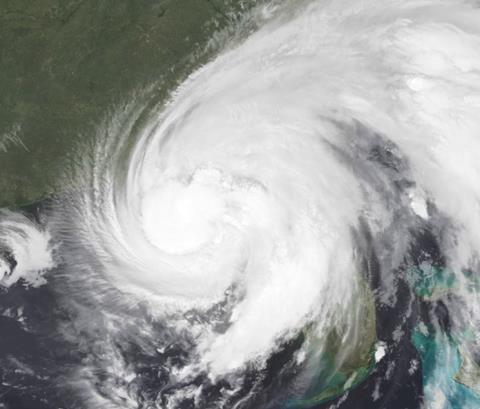Catastrophe modeller Moody’s RMS’s Hurricane Debby estimate represents insured losses associated with wind, storm surge, and precipitation-induced flooding.
Moody’s RMS Event Response has estimated the US private market insured losses for Hurricane Debby “will not exceed $1.5bn”.

Hurricane Debby was the fourth named storm of the 2024 North Atlantic hurricane season, the second hurricane, and the second named storm to make landfall in the US this season.
The cat risk modeller’s estimates reflect insured wind, storm surge, and inland flooding impacts.
The US National Flood Insurance Program loss was estimated by Moody’s RMS Event Response at “not exceeding US$300m”.
The $1.5bn figure for the private market includes insured losses for wind, storm surge, and precipitation-induced flooding.
Debby made landfall as a Category 1 hurricane near Steinhatchee, Florida on Monday 5 August.
At landfall, Debby had maximum sustained winds of 80 miles per hour (130kph) and a central pressure of 979 hPa, bringing hurricane-force winds, damaging storm surge, and heavy rainfall to portions of Florida’s Big Bend region and Gulf Coast.
“Hurricane Debby should not be a major event for the (re)insurance market,” said Jeff Waters, director, North Atlantic hurricane models, Moody’s.
“Debby made landfall just 10 to 15 miles (16 to 24 km) from last year’s Hurricane Idalia’s Florida landfall as a Category 3 hurricane. So, there is certainly some overlap of the exposures affected by both events,” he said.
Coastal and interior areas of Georgia and the Carolinas experienced heavy rainfall with widespread inland flooding as Debby meandered off the coast for several days.
After making a second US landfall at Bulls Bay, South Carolina as a tropical storm on Thursday, 8 August, Debby moved northward and eventually became post-tropical.
During this time, several Mid-Atlantic and Northeast states were impacted by precipitation-induced flooding and severe weather, including tornadoes, in some areas.
“Recovery is still ongoing in some of those affected areas, but in many cases, we expect the repaired roofs to fare better with Debby, as they now reflect more recent, stringent building codes,” Waters added.
Estimated losses reflect property damage and business interruption to residential, commercial, industrial, and automobile lines of business, and consider sources of post-event loss amplification and non-modelled sources of loss.
The wind and storm surge components for this industry-insured loss estimate were based on an analysis of ensemble footprints in Moody’s RMS Version 23 North Atlantic Hurricane Models.
These ensemble footprints are reconstructions of Debby’s hazard that capture the uncertainties surrounding observed winds and storm surge, the cat modeller said.
Similarly, the inland flood component of the loss estimate was derived using Version 1.2 of its US Inland Flood HD Model, the firm added.
Exposure informing the private market loss estimates was based on Moody’s RMS US Hurricane and US Private Flood industry exposure databases, and exposure for the NFIP loss estimate was based on Moody’s view of NFIP policy-in-force data published by FEMA.
The cat modeller said it developed and validated the wind, storm surge, and inland flood reconstructions and corresponding loss estimate using public and privately available data, including wind station observations, river gauge water level data, web-based reconnaissance, aerial imagery analysis, plus its own real-time data products.
Waters said: “Events like Debby continue highlighting the potential damage from water, notably storm surge and precipitation-induced flooding, and the need to model those sources of loss effectively when quantifying hurricane risk.
“The slow-moving nature of the storm caused excessive rainfall—in some cases beyond the 50-year return period—with subsequent widespread pluvial and fluvial flooding along the US East Coast, especially Florida and the Southeast.
“Insured flood losses will be absorbed by the NFIP, especially along coastal portions of Florida, Georgia, and the Carolinas, where take-up rates are higher, as well as the private market. However, we expect a sizable amount of uninsured flood losses from this event, particularly in non-coastal areas where NFIP take-up is much lower,” he added.
As Debby has dissipated, there is another cluster of storms gathering over the Caribbean, which are 80% likely to generate the next named storm of the 2024 Atlantic Hurricane Season, as this weather report from CNN explains.










No comments yet